| Article ID | Journal | Published Year | Pages | File Type |
|---|---|---|---|---|
| 6113567 | Critical Reviews in Oncology/Hematology | 2016 | 49 Pages |
Abstract
Primary cutaneous T-cell lymphomas (CTCLs), such as mycosis fungoides and Sézary syndrome, are a rare group of non-Hodgkin lymphomas, usually treated using a multimodal approach. Unfortunately, many patients go on to develop relapsed/refractory disease. Systemic treatment for relapsed/refractory CTCL has historically relied on chemotherapies and interferons, and while active, responses are often short-lived. Three drugs are now approved in the US to treat relapsed/refractory CTCL including the oral retinoid, bexarotene, and histone deacetylase inhibitors, romidepsin and vorinostat. Although response rates are typically <35%, romidepsin and vorinostat can induce some durable responses in heavily pretreated patients and alleviate bothersome symptoms, such as pruritus. New studies indicate that the anti-CD30 antibody-drug conjugate brentuximab vedotin, anti-CCR4 antibody mogamulizumab, and fusion protein immunotoxin A-dmDT390-bisFv(UCHT1) may be particularly active in this setting. In this paper, we present an exhaustive review of the clinical data on current and possible future drug treatment options for relapsed/refractory CTCL.
Keywords
Related Topics
Health Sciences
Medicine and Dentistry
Hematology
Authors
Pier Luigi Zinzani, Vijayveer Bonthapally, Dirk Huebner, Richard Lutes, Andy Chi, Stefano Pileri,
